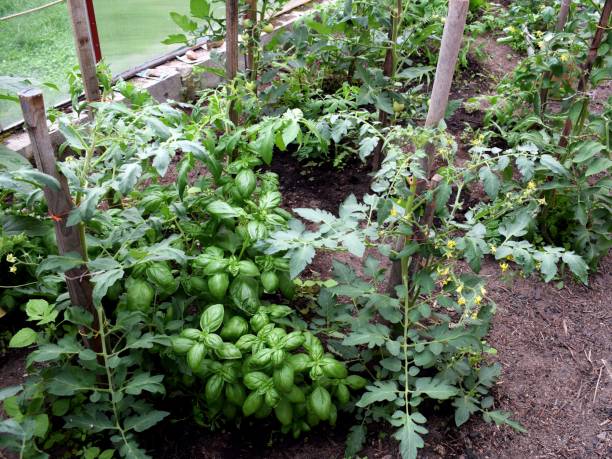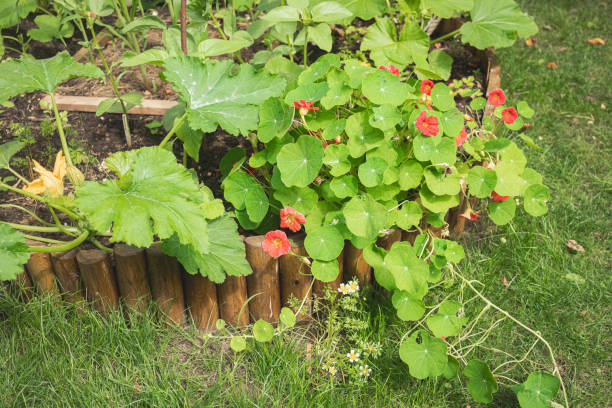You might throw your hands up in frustration after discovering aphids covering your tomatoes or cucumber beetles destroying your squash plants.
Normally, the next thing would be to grab whatever pesticide is handy at the hardware store.
But here’s what most of you don’t realize – you’re probably spending 3-5 times more on chemical solutions than you need to, and you’re creating problems that didn’t exist before.
Last season, my neighbor spent $340 on various pesticides for her quarter-acre vegetable garden. Meanwhile, I spent $45 on companion plant seeds and had virtually zero pest damage.
And YES. The difference wasn’t luck. It was understanding how plants naturally protect each other.
How Companion Plants That Are Natural Pest Deterrent Works
Let me paint a picture that might sound familiar.
You plant a beautiful garden worth $200-300 in seeds, plants, and soil amendments. Then the pests arrive. Aphids drain your plants. Cabbage worms decimate your brassicas. Cucumber beetles spread bacterial wilt through your cucurbit family.
Here’s the real financial damage: The average home gardener loses 25-40% of their harvest to pest damage annually. That’s $75-120 down the drain on a modest $300 garden investment.
Add the cost of pesticides – typically $8-15 per application for a small garden – and you’re looking at serious money.
But there’s a smarter approach that’s been hiding in plain sight for centuries.
Companion planting for pest control isn’t some new-age gardening trend. It’s integrated pest management (IPM) at its most basic level. Instead of waiting for problems and reacting with chemicals, you’re building a defense system that works 24/7 without any input from you.
The science is solid. Plants release specific compounds through their roots, leaves, and flowers. Some of these compounds repel insects. Others confuse pests by masking the scent of their target plants. A few actually kill harmful insects on contact.
For example:
1. Marigolds + Vegetable Gardens
French marigolds produce thiophenes – compounds that are toxic to many soil-dwelling pests. French marigolds can reduce root-knot nematode populations by up to 90% when used properly. That’s better than most chemical nematicides, and you can eat vegetables grown right next to them.
Plant marigolds throughout your tomato, pepper, and eggplant beds. They also work exceptionally well with brassicas like cabbage, broccoli, and kale, deterring cabbage worms and root maggots.
2. Catnip + Any Garden Crop
Catnip contains nepetalactone, which is 10 times more effective at repelling mosquitoes than DEET. Plant it around your garden borders with beans, peas, or any vulnerable crop, and you’ll create a natural barrier that also repels ants and aphids.
Cost comparison? A single catnip plant costs $3-4 and covers the same area as $25 worth of mosquito repellent sprays over one season.
You also need to watch your spacing. Pack them too tight and one plant will starve the other out.
8 Companion Plants That Are Natural Pest Deterrents
Forget all that folk wisdom nonsense you hear at the garden center. I’m done with all the garden myths floating around.
Let me give you the real deal—plant combinations that I’ve proven work, season after season —real results you can count on.
1. Basil + Tomatoes

Basil planted with tomatoes reduces aphid populations by 60-75% in most trials. The volatile oils in basil – particularly eugenol and linalool – interfere with aphid feeding behavior. Even better, basil also repels tomato hornworms and whiteflies.
One basil plant per four tomato plants is the magic ratio I’ve found works best. This combination also improves tomato flavor – there’s actual science behind this old gardener’s tale.
2. Nasturtiums + Cucumber Family

Nasturtiums function as trap crops for aphids, cucumber beetles, and squash bugs. Research shows they can reduce pest pressure on nearby cucumbers, squash, and melons by 50-80%. The key is understanding they work by attracting pests away from your main crops.
Plant nasturtiums every 3-4 feet along cucumber and squash rows. You need to monitor and remove heavily infested nasturtium plants periodically – think of them as sacrificial bodyguards for your valuable crops.
3. Chrysanthemums + Garden Perimeter
Chrysanthemums contain natural pyrethrins, the same compounds used in many organic insecticides. Plant them around the edges of vegetable beds to create a natural insect barrier. They’re particularly effective against aphids, spider mites, and flying insects that target lettuce, spinach, and other leafy greens.
4. Dill + Cabbage Family
Here’s one most people miss: dill planted near cabbage, broccoli, and cauliflower attracts beneficial wasps that parasitize cabbage worms. I’ve seen 70% reductions in cabbage worm damage when dill is properly integrated into brassica plantings.
Plant dill every 6 feet throughout your cabbage patch. Let some plants go to flower – that’s when they’re most attractive to beneficial insects.
Here’s a cost breakdown that opened my eyes: A packet of nasturtium seeds costs $2-3 and covers 20 feet of row. The equivalent area treated with organic insecticidal soap requires $15-20 worth of spray over a season. Plus, nasturtiums give you edible flowers and leaves – try that with your pesticide bottle.
Results timeline? Most companion plant benefits kick in within 2-3 weeks of planting. Marigolds need about 30 days to establish root exudates that affect soil pests. Aromatic herbs like basil and dill start repelling flying insects within days.
5. Rosemary + Bean Family
Rosemary planted near green beans, lima beans, and peas repels bean beetles and aphids. The strong aromatic oils create a protective zone around your legume crops. Space rosemary plants every 4-5 feet along bean rows.
In cold climates, use annual rosemary or move potted perennial rosemary plants into position each season.
6. Sage + Carrot Family
Sage works remarkably well with carrots, parsnips, and parsley, deterring carrot flies and aphids. The key is planting sage at the ends of carrot rows and every 8-10 feet within longer rows.
Harvest sage leaves regularly throughout the growing season – this actually increases the plant’s pest-deterrent properties by stimulating new growth.
7. Thyme + Tomato and Pepper Beds
Ground-hugging thyme varieties create a living mulch around tomatoes and peppers while repelling aphids, whiteflies, and hornworms. Plant thyme transplants 12-18 inches from main crop plants.
Thyme needs full sun and good drainage, making it perfect for raised vegetable beds.
8. Mint + Cabbage and Radish Plantings
Mint (contained in pots to prevent spreading) placed throughout cabbage family plantings deters flea beetles and cabbage moths. I use one potted mint plant per 4-foot section of row.
The same mint pots work double duty with radish plantings, reducing flea beetle damage that creates those tiny holes in radish leaves.
Spacing matters more than most people realize. Basil needs to be within 18 inches of tomatoes to provide meaningful pest protection. Any farther, and the volatile compounds don’t reach effective concentrations.
Timing varies by region, but here’s my general rule: Plant companion plants at the same time or slightly before your main crops. In zones 6-8, I start herb transplants indoors 2-3 weeks before my last frost date. This gives them time to establish before pest pressure peaks in late spring and early summer.
For areas with short growing seasons (zones 3-5), focus on fast-establishing companions like dill, cilantro, and annual flowers. Perennial herbs like rosemary and sage won’t provide much benefit their first year in cold climates.
Here’s something most articles won’t tell you: Some companion combinations don’t work in all soil types. Marigolds are less effective in alkaline soils above pH 7.5. The thiophenes they produce are less stable in high-pH conditions. If you’re gardening in alkaline soil, focus more on aromatic companions like mint, rosemary, and lavender.
The Advanced Strategies Of Companion Plants For Natural Pest Deterrent
This is what I called the “ Building-Layered-Defense” Systems.
Once you understand basic companion planting, you can create sophisticated pest management systems that work year-round using specific crop combinations.
1. Three Sisters + Nasturtium Enhancement
The traditional corn, beans, and squash combination gets supercharged when you add nasturtiums around the squash plants. The nasturtiums protect against squash bugs and cucumber beetles while the beans fix nitrogen for heavy-feeding corn and squash.
Plant nasturtiums every 3 feet around the squash hills in your three sisters setup.
2. Lettuce + Chive Intercropping
Chives planted every 12 inches throughout lettuce beds repel aphids and add a harvest bonus. The sulfur compounds in chives also help prevent fungal diseases in lettuce during humid weather.
This works especially well with butterhead and romaine varieties that have longer harvest windows.
3. Sunflower + Cucumber Beetle Defense
Tall sunflowers planted on the north side of cucumber and melon patches attract beneficial insects like ladybugs and predatory wasps. Choose varieties that bloom throughout the growing season, not just late summer types.
The trick is positioning – sunflowers provide beneficial insect habitat without shading your sun-loving cucurbits.
4. Yarrow + Pest Predator Banking
Yarrow planted in permanent beds near your rotating vegetable gardens creates habitat for beneficial insects year after year. It hosts predatory wasps, hover flies, and lacewings that hunt garden pests.
Plant yarrow in 3-foot wide strips between garden sections or around the entire garden perimeter.
Seasonal rotation keeps pest populations guessing. Many garden pests overwinter in soil or plant debris. By rotating both your main crops and your companion plants, you break pest life cycles. I move my basil-tomato combinations to different beds each year, and plant different aromatic herbs in the previous year’s locations.
5. Cold-Season Companion Combinations
Don’t forget winter and early spring plantings. Garlic planted around future tomato sites in fall provides ongoing pest deterrence through the following growing season. The same garlic works with strawberry plantings to repel aphids and spider mites.
For year-round protection, I maintain cold frames with hardy herbs through winter. Rosemary, thyme, and sage continue providing some pest deterrent effects even in cold weather. When spring arrives, these established plants give immediate protection to new plantings.
This isn’t just gardening anymore – it’s ecosystem management.
You’re creating a balanced system where plants, beneficial insects, and even soil microorganisms work together to maintain pest populations at manageable levels.
The best part? Once established, these systems become increasingly effective with minimal input. Chemical pesticides require constant reapplication and increasing doses as pests develop resistance. Plant-based pest management gets stronger and more stable over time.
Your garden becomes a model of what agriculture could look like – productive, sustainable, and in harmony with natural systems instead of fighting against them.
By implementing these companion plants that are natural pest deterrents, you’re not just saving money and avoiding chemicals – you’re creating a thriving ecosystem that gets stronger every season.
